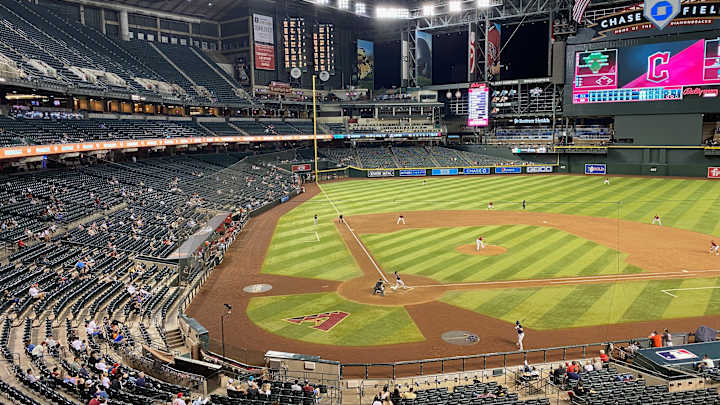Diamondbacks Home Attendance Down 25% Compared to 2019

In this story:
The Arizona Diamondbacks home attendance was down 25% per game compared to the last pre-Covid year of 2019. The raw total difference was over 530,000 fewer fans. Both the percentage and raw total gaps represent the third biggest drops among all 30 Major League Baseball teams.
There were no fans allowed into games in 2020, and 2021 began with limited numbers of fans allowed into ballparks at the outset. Many people were still hesitant to venture out into public once those limitations were removed. However 2022 began with no such restrictions in place.
While it's true that most teams have seen drops in attendance compared to 2019, few teams have suffered a bigger impact. 21 teams have seen a drop in per game attendance, and nine teams have seen an increase. Overall the average attendance drop in MLB has been 6% on a decrease from 28,201 in 2019 to 26,620 in 2022, for a net loss of 1,581 fans per game.
Here are the 15 teams with the largest drops in per game attendance, 2022 vs. 2019:
The Oakland A's have been playing in an empty ballpark all year due to a fan boycott over stadium and management issues. Only one other team, the Cleveland Guardians, have experienced a bigger percentage drop than the Diamondbacks. Only the Los Angeles Angels saw a bigger drop in the raw total so far, but they were coming down off a higher base, so the percentage decrease is not quite as severe.
Note: all data courtesy of Baseball-Reference.com. These numbers may change slightly as many teams still have a small number of home games remaining, but the D-backs home schedule is finished.
The flip side is despite challenges nine teams still enjoyed attendance increases compared to 2019, and another six had just low single digit decreases.
This is not what the Diamondbacks organization envisioned just prior to the season starting. President and CEO Derrick Hall, speaking with the Arizona Republic's Nick Piecoro, projected attendance to reach 2,000,000 fans in 2022, with several caveats. But with 1,605,199 tickets sold the team fell almost 400,000 tickets short of that projection.
"It [attendance] will be down. We’ve never had a season where we haven’t hit two million. I don’t suspect we’ll have an issue there, but it depends on how we play. If we play like we did last year, we’re going to have challenges. We know that. We’ll see it. It’s the perfect storm right now. With COVID, the work stoppage, the fact that we had such a tough season — tough last couple of seasons — I think there’s a lot of fans that are going to say, ‘Wait and see.’ I think there’s a lot of fans that are still not comfortable going out in public. We’re seeing that a little bit, too."
It's difficult to say which factors have been the biggest in the decrease in fans. The track record for the Diamondbacks in the past has been attendance decreases in the year following a bad season and increases in the year following a good season. While the D-backs have already won 71 games and are likely to exceed last year's win total of 52 by over 20 games, that improvement has clearly not been enough to entice fans over the course of the season. To be sure a sense of optimism surrounding the club is beginning to emerge due to many young players coming up from the minor leagues and playing an exciting brand of baseball. But that has yet to translate to the box office.
At the same time economic factors may have a larger impact in the Phoenix metropolitan area than in other cities. The 13% inflation rate is the highest of any city in the last 20 years.
Other factors include ongoing stadium issues with an ever growing repair list. The team was seldom able to open the roof this year due to issues with a cable that needs to be repaired during the off season. Rumors of the team potentially relocating to other areas have not helped either.
It remains to be seen if fans are ready to embrace the young core of players that have arrived and start coming out to the ballpark in larger numbers. The organization will need to invest more resources to shore up one of the worst bullpens in the majors. That reliever corps has all too often undercut the improvements being made by the position player group and younger starting pitchers. A major investment by the club in this area could possibly create some additional buzz around the team.
How far they are willing to go in that direction with such a disappointing attendance record this year remains to be seen however. After starting 2019-20 with payrolls over $120 million dollars, the 2021-22 payrolls have been under $100 million dollars. Fans and pundits alike will be monitoring the Diamondbacks offseason for signs they are ready to up that spending in an effort to truly compete for a playoff spot in 2023.

Jack Sommers is a credentialed beat writer for Arizona Diamondbacks ON SI. He's also the co-host of the Snakes Territory Podcast and Youtube channel. Formerly a baseball operations department analyst for the D-backs, Jack also covered the team for MLB.com, The Associated Press, and SB Nation. Follow Jack on Twitter @shoewizard59
Follow shoewizard59